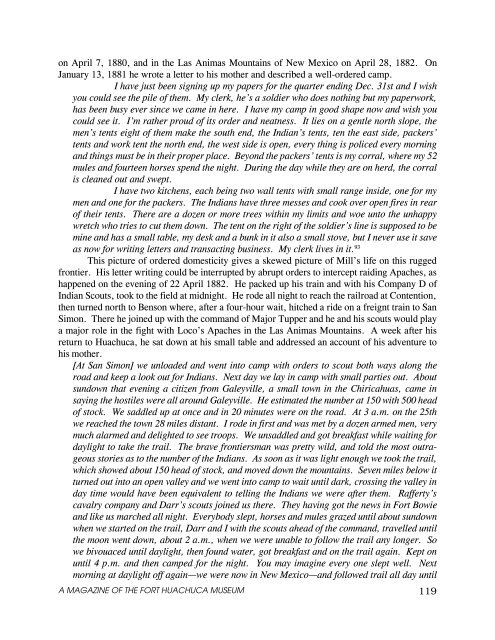Apache Campaigns - Fort Huachuca - U.S. Army
Apache Campaigns - Fort Huachuca - U.S. Army
Apache Campaigns - Fort Huachuca - U.S. Army
You also want an ePaper? Increase the reach of your titles
YUMPU automatically turns print PDFs into web optimized ePapers that Google loves.
on April 7, 1880, and in the Las Animas Mountains of New Mexico on April 28, 1882. On<br />
January 13, 1881 he wrote a letter to his mother and described a well-ordered camp.<br />
I have just been signing up my papers for the quarter ending Dec. 31st and I wish<br />
you could see the pile of them. My clerk, he’s a soldier who does nothing but my paperwork,<br />
has been busy ever since we came in here. I have my camp in good shape now and wish you<br />
could see it. I’m rather proud of its order and neatness. It lies on a gentle north slope, the<br />
men’s tents eight of them make the south end, the Indian’s tents, ten the east side, packers’<br />
tents and work tent the north end, the west side is open, every thing is policed every morning<br />
and things must be in their proper place. Beyond the packers’ tents is my corral, where my 52<br />
mules and fourteen horses spend the night. During the day while they are on herd, the corral<br />
is cleaned out and swept.<br />
I have two kitchens, each being two wall tents with small range inside, one for my<br />
men and one for the packers. The Indians have three messes and cook over open fires in rear<br />
of their tents. There are a dozen or more trees within my limits and woe unto the unhappy<br />
wretch who tries to cut them down. The tent on the right of the soldier’s line is supposed to be<br />
mine and has a small table, my desk and a bunk in it also a small stove, but I never use it save<br />
as now for writing letters and transacting business. My clerk lives in it. 93<br />
This picture of ordered domesticity gives a skewed picture of Mill’s life on this rugged<br />
frontier. His letter writing could be interrupted by abrupt orders to intercept raiding <strong>Apache</strong>s, as<br />
happened on the evening of 22 April 1882. He packed up his train and with his Company D of<br />
Indian Scouts, took to the field at midnight. He rode all night to reach the railroad at Contention,<br />
then turned north to Benson where, after a four-hour wait, hitched a ride on a freignt train to San<br />
Simon. There he joined up with the command of Major Tupper and he and his scouts would play<br />
a major role in the fight with Loco’s <strong>Apache</strong>s in the Las Animas Mountains. A week after his<br />
return to <strong>Huachuca</strong>, he sat down at his small table and addressed an account of his adventure to<br />
his mother.<br />
[At San Simon] we unloaded and went into camp with orders to scout both ways along the<br />
road and keep a look out for Indians. Next day we lay in camp with small parties out. About<br />
sundown that evening a citizen from Galeyville, a small town in the Chiricahuas, came in<br />
saying the hostiles were all around Galeyville. He estimated the number at 150 with 500 head<br />
of stock. We saddled up at once and in 20 minutes were on the road. At 3 a.m. on the 25th<br />
we reached the town 28 miles distant. I rode in first and was met by a dozen armed men, very<br />
much alarmed and delighted to see troops. We unsaddled and got breakfast while waiting for<br />
daylight to take the trail. The brave frontiersman was pretty wild, and told the most outrageous<br />
stories as to the number of the Indians. As soon as it was light enough we took the trail,<br />
which showed about 150 head of stock, and moved down the mountains. Seven miles below it<br />
turned out into an open valley and we went into camp to wait until dark, crossing the valley in<br />
day time would have been equivalent to telling the Indians we were after them. Rafferty’s<br />
cavalry company and Darr’s scouts joined us there. They having got the news in <strong>Fort</strong> Bowie<br />
and like us marched all night. Everybody slept, horses and mules grazed until about sundown<br />
when we started on the trail, Darr and I with the scouts ahead of the command, travelled until<br />
the moon went down, about 2 a.m., when we were unable to follow the trail any longer. So<br />
we bivouaced until daylight, then found water, got breakfast and on the trail again. Kept on<br />
until 4 p.m. and then camped for the night. You may imagine every one slept well. Next<br />
morning at daylight off again—we were now in New Mexico—and followed trail all day until<br />
A MAGAZINE OF THE FORT HUACHUCA MUSEUM<br />
119

















